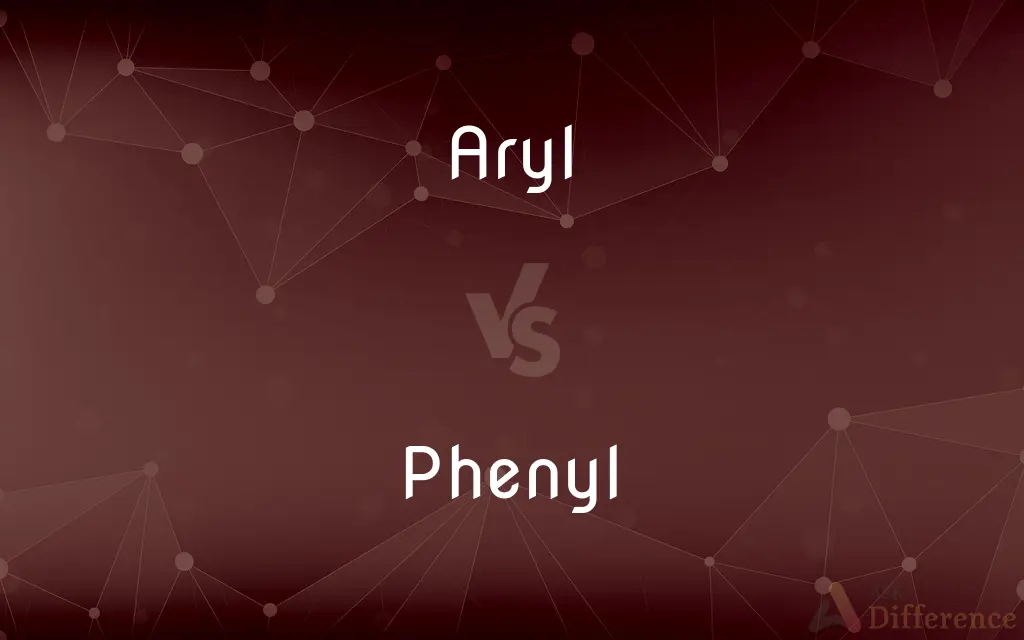Aryl vs. Phenyl — What's the Difference?
Edited by Tayyaba Rehman — By Urooj Arif — Updated on March 12, 2024
Aryl groups are a class of organic radicals derived from aromatic rings, while phenyl specifically refers to a benzene ring minus one hydrogen.

Difference Between Aryl and Phenyl
Table of Contents
ADVERTISEMENT
Key Differences
Aryl groups are derived from aromatic hydrocarbons by removing one hydrogen atom, leaving a radical that can attach to other atoms or groups. They're characterized by their stability due to the delocalized electrons in the aromatic ring. Whereas phenyl is a specific type of aryl group derived from benzene, one of the simplest aromatic hydrocarbons, by removing one hydrogen atom to form the phenyl group, symbolized as C6H5-.
While aryl groups can come from various aromatic hydrocarbons, including naphthalene, anthracene, and others, forming naphthyl, anthryl, etc., phenyl groups specifically come from benzene. This means all phenyl groups are aryl, but not all aryl groups are phenyl. For example, a naphthyl group, derived from naphthalene, is an aryl group but not a phenyl group.
The reactivity of aryl groups can vary depending on the parent aromatic hydrocarbon and the substituents on the ring. Aryl groups can participate in numerous chemical reactions, including electrophilic aromatic substitution and nucleophilic aromatic substitution, depending on the nature of the substituents. Phenyl groups, being a type of aryl group, share many of these reactions but have their unique reactivity patterns due to the specific structure of benzene.
Phenyl groups are commonly found in a wide range of organic compounds, including pharmaceuticals, dyes, and polymers, contributing to the properties of these compounds, such as UV absorption in sunscreens. Other aryl groups, derived from different aromatic hydrocarbons, also find applications in various industries but might confer different properties due to their distinct structures.
In naming chemical compounds, the distinction between aryl and phenyl is crucial for accuracy. For instance, when a benzene ring is attached to another molecule, specifying it as a phenyl group clarifies the structure, whereas using 'aryl' would be more ambiguous, not defining the exact type of aromatic ring involved.
ADVERTISEMENT
Comparison Chart
Origin
Derived from any aromatic hydrocarbon by removing one hydrogen.
Specifically derived from benzene by removing one hydrogen.
Examples
Naphthyl, anthryl, phenyl, etc.
Phenyl (C6H5-) only.
Reactivity
Reactivity varies with the type of aromatic hydrocarbon and substituents.
Specific reactivity patterns due to benzene's structure.
Applications
Used in various organic compounds, with properties depending on the specific aryl group.
Found in pharmaceuticals, dyes, polymers, affecting properties like UV absorption.
Naming Importance
Indicates the presence of an aromatic ring, but not its specific type.
Specifies the presence of a benzene ring in the compound.
Compare with Definitions
Aryl
Aromatic Radical
The aryl group in that molecule contributes to its reactivity.
Phenyl
Benzene Derivative
The phenyl group is essentially a benzene ring minus one hydrogen atom.
Aryl
Diverse Origin
Aryl groups can be derived from complex aromatic compounds like anthracene.
Phenyl
Specific Structure
The phenyl group, C6H5-, is known for its stability and aromaticity.
Aryl
Wide Applications
Aryl groups are integral to the structure of many industrial chemicals.
Phenyl
Structural Clarification
Specifying a phenyl group in a molecule clarifies its benzene-based structure.
Aryl
Variable Reactivity
The substituents on the aryl group affect its participation in chemical reactions.
Phenyl
Unique Reactivity
Phenyl groups undergo electrophilic substitution reactions characteristic of benzene.
Aryl
Structural Variety
The naphthyl group is an example of an aryl group with a distinct structure.
Phenyl
Common in Organics
Phenyl groups are a common feature in many pharmaceutical compounds.
Aryl
In the context of organic molecules, aryl is any functional group or substituent derived from an aromatic ring, usually an aromatic hydrocarbon, such as phenyl and naphthyl. "Aryl" is used for the sake of abbreviation or generalization, and "Ar" is used as a placeholder for the aryl group in chemical structure diagrams, analogous to “R” used for any organic substituent.
Phenyl
An aromatic hydrocarbon unit, C6H5, that can occur as a substituent in an organic compound or as an ion or radical, structurally related to benzene.
Aryl
A compound containing benzene or another aromatic hydrocarbon, or a univalent group derived from such a compound by removal of a hydrogen atom attached to the aromatic ring.
Phenyl
(organic chemistry) A univalent hydrocarbon radical (C6H5) formally derived from benzene by the removal of a hydrogen atom, and the basis of an immense number of aromatic derivatives.
Aryl
(organic chemistry) Any univalent organic radical derived from an aromatic hydrocarbon by removing a hydrogen atom.
Phenyl
A hydrocarbon radical (C6H5) regarded as the essential residue of benzene, and the basis of an immense number of aromatic derivatives.
Common Curiosities
How does a phenyl group differ from other aryl groups?
A phenyl group is specifically derived from benzene, making it a type of aryl group with the structure of benzene minus one hydrogen.
How are phenyl groups identified in chemical structures?
Phenyl groups are identified by their benzene ring structure attached to another atom or group, represented as C6H5-.
Can all aryl groups be called phenyl groups?
No, only aryl groups derived from benzene can be called phenyl groups.
Are aryl groups only found in synthetic compounds?
No, aryl groups can also be found in natural compounds, including those from plants and animals.
How do substituents on an aryl group affect its chemistry?
Substituents can influence the electronic and steric properties of aryl groups, affecting their reactivity and interactions with other molecules.
Are phenyl groups capable of forming polymers?
Yes, phenyl groups can be part of monomers that polymerize, contributing to the properties of the resulting polymers.
What is an aryl group?
An aryl group is a functional group derived from an aromatic hydrocarbon by removing one hydrogen atom.
What role do aryl groups play in organic chemistry?
Aryl groups contribute to the reactivity, stability, and properties of organic compounds due to their aromatic nature.
Can the term 'aryl' be used interchangeably with 'phenyl'?
While 'phenyl' is always 'aryl,' using 'aryl' when 'phenyl' is meant can lead to ambiguity, as 'aryl' could refer to any aromatic radical.
Do aryl and phenyl groups have the same reactivity?
Their reactivity can vary; phenyl groups have specific reactivities due to benzene's structure, while other aryl groups' reactivity depends on their parent aromatic hydrocarbon.
How does the presence of a phenyl group affect a molecule's properties?
A phenyl group can influence a molecule's physical and chemical properties, such as its boiling point, stability, and reactivity.
What is the significance of aryl groups in drug design?
Aryl groups are significant in drug design for their ability to interact with biological targets, affecting the drug's efficacy and pharmacokinetics.
What types of reactions are aryl groups involved in?
Aryl groups participate in various reactions, including electrophilic aromatic substitution, nucleophilic aromatic substitution, and coupling reactions.
Can aryl groups attach to non-aromatic rings?
Yes, aryl groups can attach to non-aromatic rings, influencing the properties and reactivity of those compounds.
What distinguishes a phenyl group from a benzyl group?
A phenyl group is a benzene ring minus one hydrogen, while a benzyl group includes the benzene ring plus a CH2 group.
Share Your Discovery

Previous Comparison
Bye vs. Peace
Next Comparison
Newsreader vs. NewscasterAuthor Spotlight
Written by
Urooj ArifUrooj is a skilled content writer at Ask Difference, known for her exceptional ability to simplify complex topics into engaging and informative content. With a passion for research and a flair for clear, concise writing, she consistently delivers articles that resonate with our diverse audience.
Edited by
Tayyaba RehmanTayyaba Rehman is a distinguished writer, currently serving as a primary contributor to askdifference.com. As a researcher in semantics and etymology, Tayyaba's passion for the complexity of languages and their distinctions has found a perfect home on the platform. Tayyaba delves into the intricacies of language, distinguishing between commonly confused words and phrases, thereby providing clarity for readers worldwide.














































